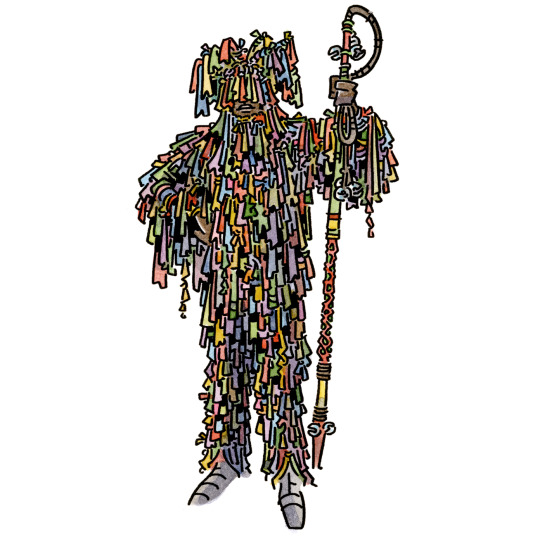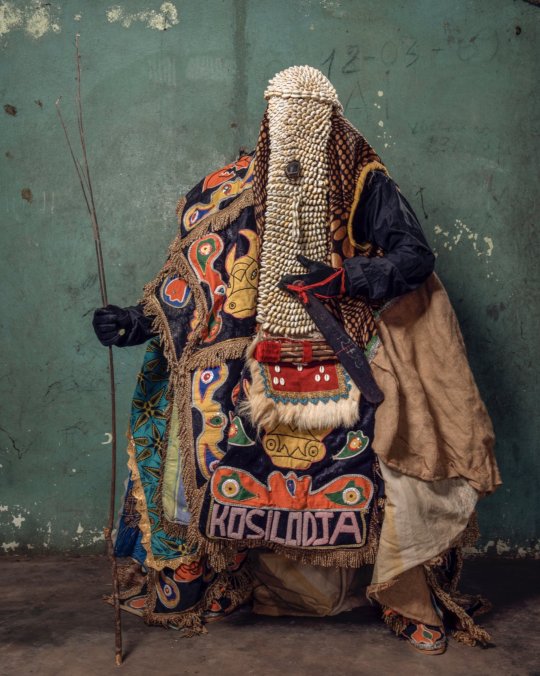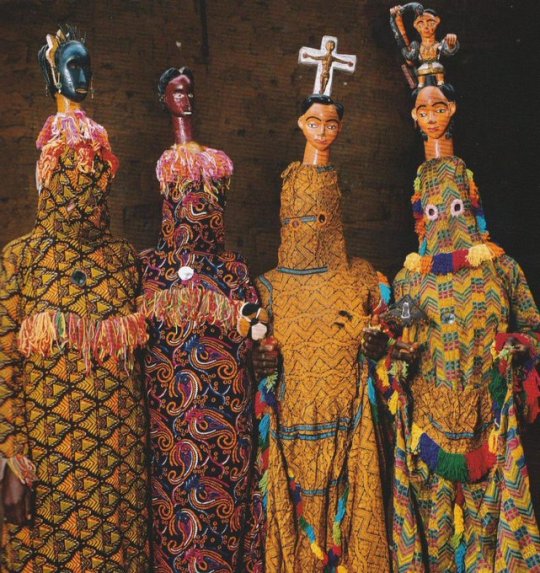#jonkonnu
Photo

Companions of Christmas 13: Pitchy Patchy
Once a highly decorated Akan military commander, the man who would become known as Pitchy Patchy was stolen from his home and enslaved in Jamaica, but he was able to escape to freedom and, operating from the Maroon towns that he helped to defend, would regularly lead raids against the plantations to free others.
Since the folks that he rescued didn’t have access to the kinds of ornate trophies and medals that he’d worn in the past, they would honor him with a simple strip of colored cloth as a sign of their gratitude for his valor. He saved so many people that he was eventually festooned with these cloth strips, to the point that they covered his entire body.
At Christmastime, he would parade boldly through the streets during the festival of Jonkonnu (or Jankunu, or Junkanoo, etc), and he continues to be a part of Jonkonnu parades to this very day.
85 notes
·
View notes
Text



Yoruba egúngún by Stephan Gladieu
Masquerades of Nigeria, 2004
Jonkonnu, a Jamaican traditional band of masqueraders
4 notes
·
View notes
Text

Trinidad and Tobago: CIRC shares Thursday Reads on Caribbean: Jonkonnu - Writeups 24 - writeups24 http://dlvr.it/Sh9s0T
0 notes
Video
youtube
Junkanoo
0 notes
Text

Winslow Homer (1836-1910)
"Dressing for the Carnival" (1877)
Oil on canvas
Realism
Located in the Metropolitan Museum of Art, New York City, New York, United States
In this Reconstruction-era painting, Homer evokes the dislocation and endurance of African American culture that was a legacy of slavery. The central figure represents a character from a Christmas celebration known as Jonkonnu, once observed by enslaved people in North Carolina and, possibly, eastern Virginia. Rooted in the culture of the British West Indies, the festival blended African and European traditions. After the Civil War, aspects of Jonkonnu were incorporated into Independence Day events; the painting’s original title was Sketch—4th of July in Virginia. The theme of independence was particularly relevant in 1877, when emancipated Black Americans in the South saw an end to their brief experience of full civil rights with the final withdrawal of federal troops.
#paintings#art#artwork#genre painting#genre scene#winslow homer#oil on canvas#fine art#realism#the metropolitan museum of art#the met#museum#art gallery#history#african american#black people#clothing#clothes#family#children#slavery#jamaica#caribbean#1870s#late 1800s#late 19th century
64 notes
·
View notes
Text
Junkanoo is a street parade with music, dance, and costumes with origin in many islands across the English speaking Caribbean every Boxing Day (26 December) and New Year's Day (1 January). These cultural parades are predominantly showcased in the Bahamas where the music is also mainstreamed, and competition results are hotly contested, There are also Junkanoo parades in Miami in June and Key West in October, where local black populations have their roots in the Caribbean. In addition to being a culture dance for the Garifuna people, this type of dancing is also performed in The Bahamas on Independence day and other historical holidays. Historically, Junkanoo parades were also found in Southeastern North Carolina.
However, the custom became less popular after slavery was abolished. The last known Jonkonnu celebration in the Southern United States was in Wilmington, N.C., in the late 1880s.
The festival may have originated several centuries ago, when enslaved descendants of Africans on plantations in The Bahamas celebrated holidays granted around Christmas time with dance, music, and costumes. After emancipation the tradition continued and junkanoo evolved from simple origins to a formal, organised parade with intricate costumes, themed music and official prizes within various categories.
The origin of the word junkanoo is disputed. Theories include that it is named after a folk hero named John Canoe or that it is derived from the French gens inconnus (unknown people), as masks are worn by the revelers.
According to Edward Long, an 18th-century Jamaican slave owner/historian, the John Canoe festival was created in Jamaica and the Caribbean by enslaved Akans who backed the man known as John Canoe. Canoe, an Ahanta from Axim, Ghana, was an ally soldier for the Germans, until one day he turned his back on them for his Ahanta people and sided with Nzima and troops in order to take the area from the Germans and other Europeans. The news of his victory reached Jamaica and he has been celebrated ever since that Christmas of 1708 when he first defeated Prussic forces for Axim. Twenty years later his stronghold was broken by neighbouring Fante forces aided by the military might of the British.
Ahanta, Nzima and Fante captives were taken to Jamaica as prisoners of war. The festival itself included motifs from battles typical of Akan fashion. The many war masks and war dance formations of Ahanta people became part of this celebration the world over, especially in the Caribbean. The elaborate masks and attire resemble Akan battledress with charms, referred to as a "Batakari".

Djékanou is a town in central Ivory Coast. right in the middle of the Akan population of that country. It is a sub-prefecture of and the seat of Djékanou Department in Bélier Region, Lacs District. Djékanou is also a commune
#junkanoo#african#afrakan#akan#igbo#yoruba#caribbean#kemetic dreams#brownskin#afrakans#africans#brown skin#african culture#deep reddish brown skin#epic video
191 notes
·
View notes
Video
youtube
A Black People's History of Christmas
How have black Americans celebrated Christmas over the years? What was Christmas like for the enslaved on America’s plantations? What was the significance of eggnog? Which 19th-century tradition involved black people dressing up in costume, caroling, and harassing white people for alcohol and trinkets?
How has Christmas been a tool of liberation and radical action? How did we get Black Santas? (Holidays, Frederick Douglass, Booker T Washington, Harriet Tubman, Saturnalia, Rome, Christmas Rebellion, Huddie Leadbelly Ledbetter, Kwanzaa, John Canoe, John Jonkonnu, Birmingham Church Bombing, Operation Breadbasket, Jesse Jackson, James Baldwin, Tis The Season)
2 notes
·
View notes
Text
Tower 5 Media - Joey Katos
At Tower 5 I've been helping Shenna out with a couple of edits from her clients. For example, the Jonkonnu and Intercultural Festival complication, although it hasn't been anything too crazy since the last update. I've enjoyed this internship because it keeps me up on my editing skills and Shenna always teaches me new techniques on Premiere Pro.
I enjoying my time at Tower 5 and, sadly, it's almost coming to its end. I enjoyed working on "My Last Goodbye" and learning how to edit a narrative story properly because I rarely edit narratives. I'm also hyped to get an IMDb credit as an editor and camera operator, super grateful that Shenna trusted me to help her out on camera. Super happy with the time with Tower 5 Media!



1 note
·
View note
Text
The traditional performance of Jonkonnu follows a particular rhythm with predetermined steps and choreography, connecting death, resurrection, and creolized behaviors. As a former colony, Jamaican Jonkunnu “is [a] traditional street festival based on age old rituals brought with the African slave on his middle passage” that occurs during Christmas time and includes “several members of a troupe elaborately, often frighteningly costumed as traditional characters” (Ryman, 2012, 124). Different members of the troupe don excessive, aesthetically exaggerated costumes with a strong emphasis on masking – which are, according to Wynter, a relic of African spirituality while mocking or imitating English ballroom dancing. Weaving African and English elements, Jonkonnu is a site of acculturation that symbolizes “the renewal and continuance of life” as a sort of “medicine dance” that “distils the medicine ‘in rhythmic waves which reach the trees and animals and houses and people’” (Ryman, 2012, 125). Core to the labor of Jonkonnu, like many Caribbean traditions, is combining religion and culture, which “sprung out of a people’s response to that dehumanization which would convert them into merchandise [and] out of resistance to European culture which defined them as the opposite of light, purity, grace, and spirit” (Wynter, 1972, 65). In response to a system of plantation slavery and a epistemological system that defined humanism and whiteness in opposition to Blackness, Caribbean rituals are a matrix of cultural, religious, and historical practices that conjure a sense of being alive and being present. This form of healing through music, rhythm, and dance defies a Western Mind/Body division and produces an aesthetic experience that incorporates sensual pleasure and the divine.
0 notes
Text

The Queen of Sets, grand dame of holiday pageantry - the last figure for this year's offerings in the Companions of Christmas series, which spotlights winter Holiday characters from around the world. Pencils (drawn digitally) on the right, inks on the left, ready to be painted up.
Here's the source for this costume, part of a series of drawings of characters/costumes drawn from life in 1836 by Isaac Mendes Belisario at the end-of-December Jonkonnu festival, to which I made very few changes in design (most of those to illicit an overall shape more conducive to cut-outs).

19 notes
·
View notes
Photo

Celebrating Christmas
Jonkonnu in North Carolina
In antebellum North Carolina, Christmas season was the time for an African American celebration found almost nowhere else in North America, but widespread through the islands of the Caribbean. Variously called Jonkonnu, Johnkannaus, John Coonah, or John Canoe, the custom was described in the slave community of Jamaica in the late eighteenth century where it was thought to have been of African origin. Although the details often changed from place to place, Jonkonnu usually involved several African American men who dressed in costumes made of rags and animal skins with grotesque masks and horns. Sometimes one of their number wore his best clothes instead. They danced wildly, often playing musical instruments and singing. In towns, the Jonkonnu men went from house to house while on plantations they performed at the homes of masters, overseers, and other white people. They expected to be rewarded with gifts of money or liquor. Jonkonnu dancers were often accompanied by crowds of men and women who cheered them on while taking no direct part in the performance.
https://www.ncpedia.org/anchor/jonkonnu-north-carolina
7 notes
·
View notes
Photo

Winslow Homer. Dressing for the carnival Уинслоу Хомер. Подготовка к карнавалу 1877
#onlyartpainting#winslowhomer#usa#XIX#women#men#festival#carvivale#south#jonkonnu#dress#costume#sun#libertycap#genrescene#realism#painting#art#onlyart
8 notes
·
View notes
Photo

Winslow Homer - Dressing for the Carnival, 1877, oil on canvas
Winslow Homer (1836-1910) is an American landscape and seascape painter and printmaker who is mostly self taught. Homer began his career as a comercial artist. He worked as an artist correspondent during the American Civil War.
15 notes
·
View notes
Video
youtube
African american jonkonnu celebration in NC. We soooo need to revive this holiday and make it bigger and better than ever!
#AA#african american#African American Culture#culture#holiday#african american holiday#christmas#jonkonnu#dancers#music
11 notes
·
View notes

